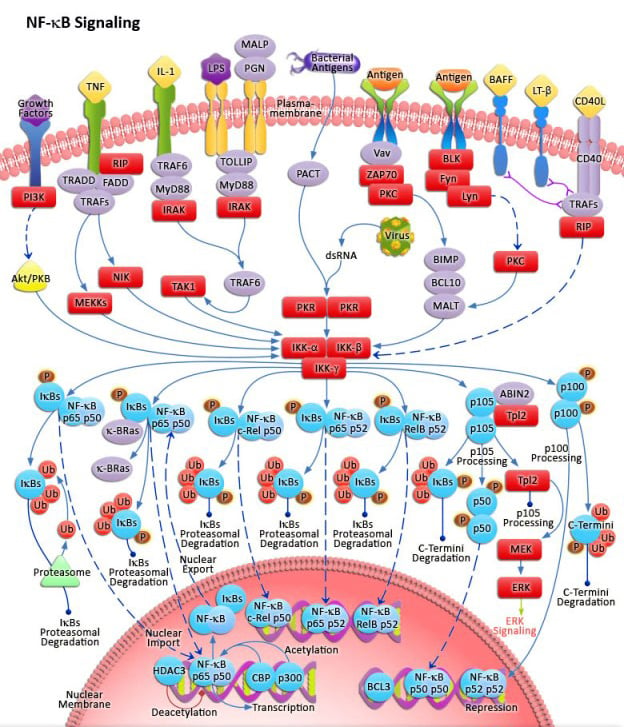NF-kB Pathway Antibodies
Nuclear Factor kappa-light-chain-enhancer of activated B cells or NF-κB is found in almost all animal cells and is a protein complex that controls the transcription of DNA. This protein complex is involved in numerous cellular responses and plays a key role in regulating the immune response to infection. NF-κB is also implicated in processes of synaptic plasticity and memory that require additional avenues of research to flesh out completely the possibilities and uses of this compound.
All proteins of the NF-κB family share a Rel homology domain in their N-terminus. A subfamily of NF-κB proteins, including RelA, RelB, and c-Rel, have a transactivation domain in their C-termini. In contrast, the NF-κB1 and NF-κB2 proteins are synthesized as large precursors, undergoing processing to generate mature and active NF-κB subunits.
NF-κB is detected in most cell types, and specific NF-κB binding sites are identified in promoters and enhancers of an increasing number of inducible genes. The transcription factor NF-κB consists of homo- or heterodimers of different subunits, members of a family of structurally related proteins–Rel/NF-κB proteins. Rel proteins contain a conserved N-terminal region, called the Rel Homology Domain (RHD), which contains the DNA-binding and dimerization domains and the nuclear localization signal of the Rel proteins.
NF-κB Activation
NF-κB can be activated by several stimuli, including exposure of cells to Lipopolysaccharides or inflammatory cytokines such as Tumor Necrosis Factor or Interleukin-1, growth factors, lymphokines, oxidant-free radicals, inhaled particles, viral infection, or expression of certain viral or bacterial gene products. Activation of NF-κB occurs according to specific and sequential phosphorylation of residues such as Ser32 and Ser36 of IκBa leading to proteasome-mediated degradation. Further, phosphorylation of Ser 276 on RelA/p65 allows its oligomerization and regulation of DNA-binding. NF-κB phosphorylation is crucial for the regulation of the NF-κB Activation.
Significance and Uses of NF-κB
NF-κB is important in regulating cellular responses because it belongs to the category of "rapid-acting" primary transcription factors. These transcription factors are present in cells in an inactive state and do not require new protein synthesis to be activated, allowing NF-κB to be a first and fast responder to harmful cellular stimuli. Receptor activator of nuclear factor kappa B, which is a type of TNFR, is a central activator of NF-κB. Many bacterial products and stimulation of a wide variety of cell-surface receptors lead to NF-κB activation and fairly rapid changes in gene expression.
NF-κB Research
NF-κB is widely used by eukaryotic cells as a regulator of genes that control cell proliferation and cell survival, thus many human tumors have unregulated or non-regulated NF-κB. NF-κB is extremely useful to identify and understand how cancer is regulated. Active NF-κB turns on the expression of genes that keep the cell proliferating and protect the cell from conditions that would otherwise cause its death through apoptosis mechanism.
In tumor cells, NF-κB is active either due to mutations in genes encoding the NF-κB transcription factors themselves or in genes that control NF-κB activity. Blocking NF-κB can cause tumor cells to stop proliferating, die, or become more sensitive to the action of anti-tumor agents. Therefore, NF-κB is the subject of much active research among pharmaceutical companies as a target for anti-cancer therapy.
NF-κB controls many genes involved in inflammation and is found to be chronically active in many inflammatory diseases, such as inflammatory bowel disease, arthritis, sepsis, gastritis, asthma, atherosclerosis. Many natural products described as having anti-cancer and anti-inflammatory activity have been shown to inhibit NF-κB. Recent studies have highlighted the importance of the connection between NF-κB, inflammation, and cancer while underscoring the value of therapies that regulate NF-κB activity.